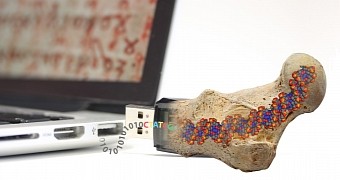There are many ways to store data digitally, but the most sophisticated and recent also tend to be the ones likely to survive the passage of time the least. We won't be relegated to punch cards, but in order to set up a time-proof database, we can't use HDDs or SSDs either.
Optical disks are the way to go for most people, and there are some types of optical media devices that can last for a long time.
There was even a granite-based DVD a few years back, which had the potential to last for one or two thousand years.
There are various reasons why man would want to leave data packages. Say we manage to kill ourselves with a nuclear holocaust, or maybe a meteor screws up the world.
It would be useful to leave some of our sciences, or the theory for them, for the future. If not, leaving warning in areas where toxic waste is buried might be the way to go.
Of course, there are some who argue that future civilizations will dig up the place from curiosity or pigheadedness regardless, so it might be a good idea not to leave any signs of things being buried at all, lest things be mistaken for treasure clues. But we digress.
Researchers led by Robert Grass, a lecturer at ETH Zurich’s Department of Chemistry and Applied Biosciences, have introduced a way to store information basically forever.
The Synthetic fossil
The plan is to encapsulate information-bearing segments of DNA in glass and then use an algorithm to correct the mistakes in the data.
This builds on the breakthrough of two years ago, when the scientific community showed that it was possible to store data in the form of DNA.
The main issue with this method is that DNA interacts chemically with the environment and can change drastically because of that.
Genetic material found in fossilized bones, however, can be isolated and analyzed easily enough, because it was kept isolated and, thus, unchanged for hundreds of thousands of years.
Thus the plan to create a synthetic fossil. Rather than wait for sediments to naturally surround a data-holding DNA batch, we can just encapsulate the DNA in silica spheres with a diameter of around 150 nanometres.
The test
Researchers exposed the synthetic fossil to a temperature of between 60 and 70 degrees Celsius for around a month, thus simulating the kind of degradation that would otherwise extend over hundreds of years.
As it is now, the method can store data for over a million years, versus microfilm's ability to extend over 500 years with degradation.

 14 DAY TRIAL //
14 DAY TRIAL //